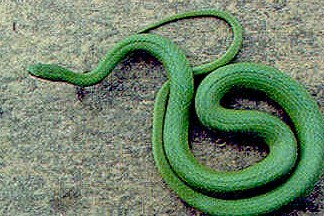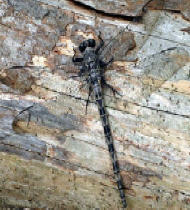Table of Contents
Greentail
Time to introduce our new high performance cluster greentail, an Hewlett Packard HPC solution. If you want to read more about the details of the hardware, you can find it at Enternal Link. The name refers to the Smooth Green Snake, which no surprise, has a green tail. External Link for more information. The reference for greentail is because this cluster consumes 18-24% less power/cooling than the competing bids.
In order to accommodate the new cluster, we have reduced the Blue Sky Studios cluster from 3 racks in production to a single rack. That rack contains nothing but 24 gb memory nodes offering just over 1.1 TB of memory across 46 nodes. Because the cluster is not power consumption friendly, it is our “on demand” cluster. If jobs are pending in the sole bss24 queue (offering 92 job slots), we will get notified and will power on more nodes. Or just email us. If it is not being used, we'll power down the nodes. The login node for this cluster is host sharptail (which can only be reached by first ssh into host petaltail or swallowtail, then ssh to sharptail).
There are no changes to the Dell cluster (petaltail/swallowtail). However be sure to read the home directory section below. It is important that all users understand the impact of changes to come.
If we like the HP management tools, in the future we may ingest cluster petaltail/swallowtail and sharptail into greentail for a single point of access. Regardless of that move, the home directories will be served by greentail in the future. That is a significant change. More details below.
As always, suggestions welcome.
Design
The purchase of the HP hardware followed a fierce bidding round in which certain design aspects had to be met.
- We continually run out of disk space for our home directories. So the new cluster had to have a large disk array on board.
- We wanted more nodes, with a decent memory footprint (settled on 12 gb per node).
- All nodes should be on an Infiniband switch.
- A single queue is preferred.
- Data (NFS) traffic was to be served up via a secondary gigabit ethernet switch, hence not compete with administrative traffic.
- (With the HP solution we will actually route data (NFS) traffic over the infiniband switch using OFED/MPI, a practice called IPoIB)
- Linux (Redhat or CentOS) as operating system.
- Flexible on scheduler (options: Lava, LSF, Sun Grid Engine)
- The disk array, switches and login node should be backed by some form of UPS (not the compute nodes)
- (We actually have moved those to our enterprise data center UPS, which is backed by building generator)
Performance
During the scheduled power outage of December 28th, 2010, some benchmarks were performed on old and new clusters. To read about the details of all that, view this page.
In short using linpack (More about Linpack on wikipedia) here are the results. The results are dependent on the combination of total memory, total cores, and speed of processors.
- greentail's nodes, all on Voltaire infiniband switch, are capable of just over 1,500 gigaflops or 1.5 teraflops.
- petaltail/swallowtail's nodes on Cisco infiniband switch are capable of 325 gigaflops
- petaltail/swallowtail's nodes on Force 10 ethernet switch are capable of 245 gigaflops
- so the total is 570 gigaflops, but you'd never want to run across both switches simultaneously
- sharptail's nodes on HP ProCurve ethernet switch are estimated at delivering between 500-700 gigaflops
- never got quite all the nodes working together, not sure why
Home Dirs
The home directory disk space (5 TB) on the clusters is served up via NFS from one of our data center NetApp storage servers (named filer3). (Lets refer to those as “old home dirs”). We will be migrating off filer3 to greentail's local disk array. The path will remain the same on greentail: /home/username. (Lets refer to those as “new home dirs”).
In order to do this, your old home directory content was copied over christmas-newyears break to greentail. Since then, it will be refreshed weekly from filer3 to greentail's disk array.
- When you create new files in your old home dirs they will show up on greentail's new home dirs after a week.
- If you delete files in old home dirs, and they have already been copied over, the files will remain in your new home dirs.
- If you create new files in greentail's new home dirs they will not be copied back to your old home dirs.
- If you modify a file on greentail's new home dirs that also exists on the old homes dirs, you will loose your changes when the weekly refresh happens.
To avoid a conflict between home dirs I strongly suggest you create a directory to store the files you will be creating on greentail's new home dirs, for example /home/username/greentail or /home/username/hp. That way the weekly refresh will not interfere with new files created on greentail.
At some point in the future, greentail's new home dirs will be mounted on the petaltail/swallowtail and sharptail clusters. Filer3's old home dirs content will then disappear permanently.
Greentail's new home dirs will provide 10 TB of disk space. Again, the clusters file systems should not be used to archive data. Doubling the home directory size should provide much needed relief.
Because of the size of the new home dirs, we will also not be able to provide backup via TSM (Tivoli). Backup via TSM to our Virtual Tape Library (VTL) will be replaced with disk to disk (D2D) backup on greentail's disk array. That has some serious implications. Please read the section about Rsnapshot.
Passwords
The password, shadow and group files of host petaltail were used to populate greentail's equivalent files.
If you change your password, do it on all four hosts (petaltail, swallowtail, sharptail and greentail).
I know, a pain.
SSH Keys
You can log in to host greentail directly (ssh username@greentail.wesleyan.edu). VPN required for off campus access.
Within the directory /home/username/.ssh there is a file named authorized_keys. Within this file are public SSH keys. Because your home directory contents are copied over to host greentail, you should be able to ssh from host petaltail or swallowtail to host greentail without a password prompt. If not, your keys are not set up properly. You may need to add your id_rsa.pub content to this file.
Note: the software stack on host petaltail (administrative server) creates ssh keys for you automatically upon your first login, so for most of you this is all set. To set up your private/public ssh keys manually:
- log into a host, then issue the command
ssh-keygen -t rsa - supply an empty passphrase (just hit return)
- then copy the contents of /home/username/.ssh/id_rsa.pub into the file authorized_keys
- you can have multiple public ssh key entries in this file
The file known_hosts contains server level ssh keys. This is necessary for MPI programs to log into compute nodes without a password prompt and submit your jobs. That file has been prepped for you.
Rsnapshot
Rsnapshot can be used to perform disk to disk backup of file systems using linux tools such as hard and soft links and rsync. It will replace our practice of backing up to the virtual tape library. Since I had to disable the functionality of keeping modified files for 30 days (one file version only) because of the mass of files in /home (18 million by last count) we actually gain functionality using rsnapshot. Rsnaphot will take daily, weekly and monthly point in time backups. We will keep backups for the last 6 days, the last 4 weeks and the last 3 months.
Rsnaphot content of all the new home directory content is made available to you at /snapshot/repository/? where ? is a single letter from a to z. This file system is read only. Users can retrieve deleted data by simply copying the data lost back into their new home directories.
Within the snapshot repository you will find directories:
- daily.0 (yesterday), daily.1 (day before yesterday) etc … daily backups are taken mon-sat at 11 pm
- weekly.0 (last week), weekly.1 (week before last week) etc … weekly backups are taken sunday at 10:30 pm
- monthly.0 (last month), monthly.1 (month before last month) etc … monthly backups are taken on the first day of each month at 10:00 pm
/home and /snapshot are different logical volumes using a different set of disks to protect against loss of data. In addition, both use RAID 6 (double parity) for another layer of protection. However, it is one disk array comprised of 4 disk shelves directly attached to greentail. A catastrophic failure implies the potential of data loss. I therefore encourage you to archive data elsewhere for permanent storage.
Sanscratch
Previously there were two scratch areas available to your programs: /localscratch which is roughly 50 GB on each node's local hard disk and /sanscratch a shared scratch area available to all nodes. Sanscratch allows you to monitor your jobs progress by looking in /sanscratch/jobpid. It was also much larger (1 TB).
However, since our fantastic crash of June 2008 (The catastrophic crash of June 08 page) /sanscratch was simply a directory inside /home and thus competes for disk space and IO.
On greentail, /sanscratch will be a separate logical volume of 5 TB using a different disk set. So I urge those that have very large files, or generate lots of IO, to stage their files in /sanscratch/jobid when running their jobs for best performance. The scheduler will always create (and delete!) two directories for you. The JOBPID of your job is used to create /localscratch/jobpid and /sanscratch/jobpid.
MPI
For those of you running MPI or MPI enabled applications, you will need to make some changes to your scripts. The wrapper program to use with greentail's Lava scheduler is the same as for cluster sharptail. It can be found here: /share/apps/bin/lava.openmpi.mpirun. If other flavors are desired, you can inform me or look look at the example scripts lava.mpi_flavor.mpi[run|exec].
Sometime ago I wrote some code to detect if a node is infiniband enabled or not, and based on the result, add command line arguments to the mpirun invocation. If you use that code, you will need to change: the path to obtain the port status (/usr/bin/ibv_devinfo) and in the block specifing the interface change eth1 to ib0.
Software
The same /share/apps software directory build when we were working petaltail as a new administrative host has been copied to greentail. Petaltail is redhat linux 5.1 while greentail is redhat linux 5.5. I anticipate everything to work but we may encounter missing libraries (major/minor versions).



